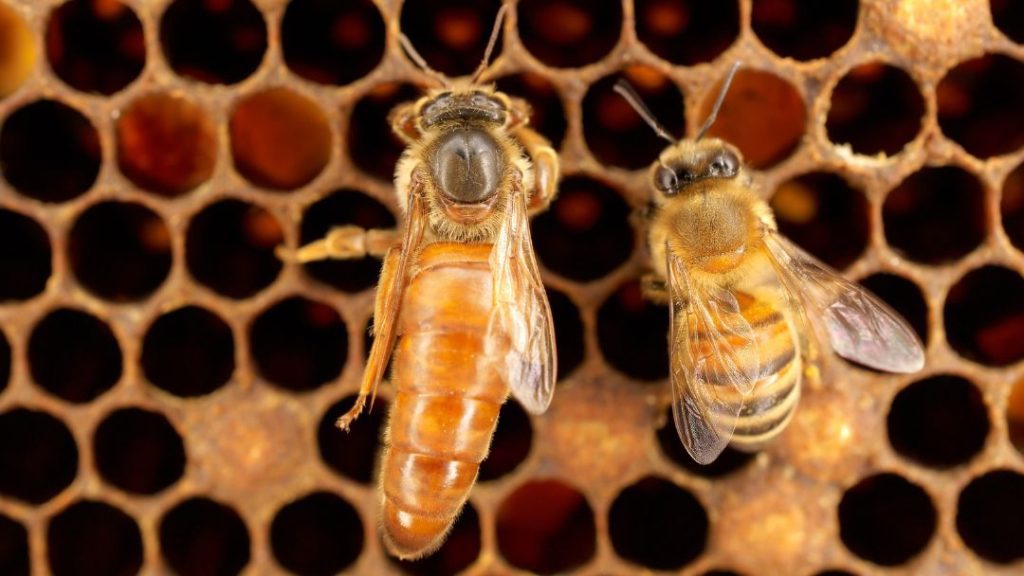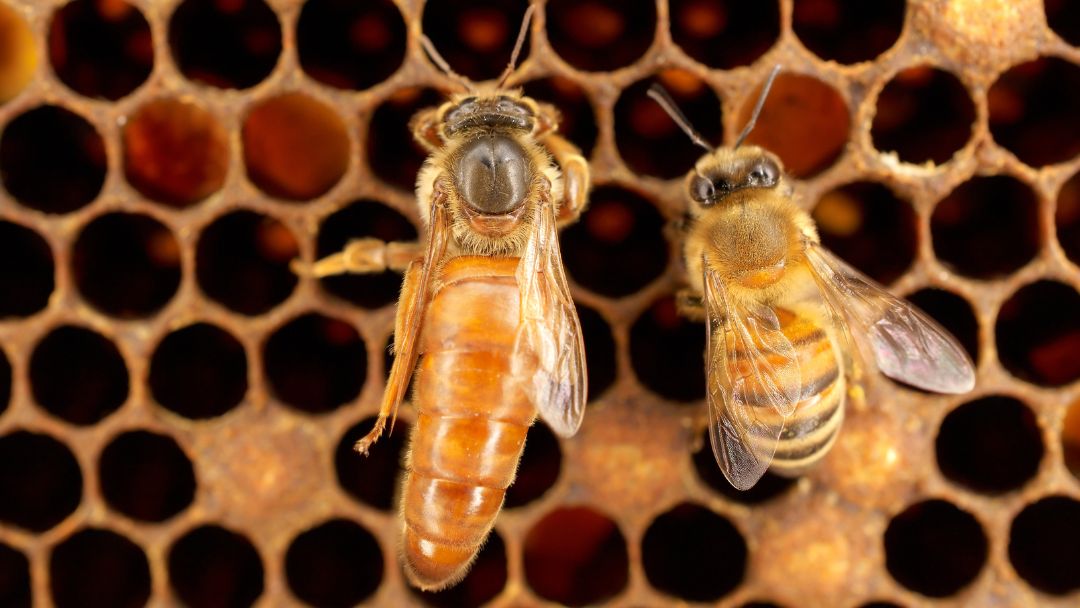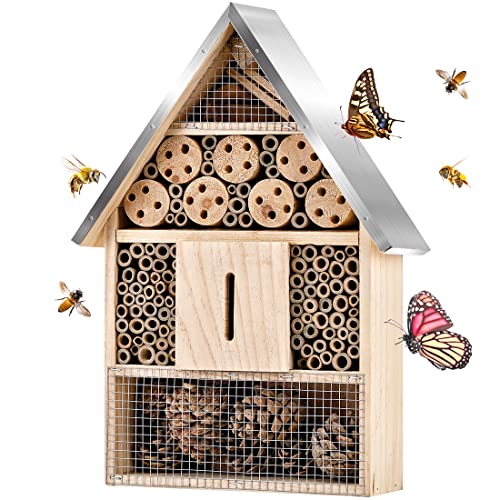Why and When to Consider Requeening
Requeening should be considered when an existing queen is aging or underperforming, to maintain a productive hive. The decision is usually made after observing reduced brood production, increased aggression, or inconsistent laying patterns.
When a honeybee colony starts to exhibit signs of decline, requeening becomes necessary to ensure the overall health and vitality of the hive. This process involves replacing the existing queen with a new one that is young, healthy, and genetically diverse.
Requeening is typically recommended if the current queen is nearing the end of her lifespan or if she is not meeting the desired performance standards. This can manifest as a decrease in brood production, an increase in aggression, or irregular egg-laying patterns.
By replacing the queen promptly, beekeepers can help maintain a strong and thriving colony, ultimately benefiting honey production and the overall honeybee population.
What Is Requeening?
Requeening is an essential practice in beekeeping that involves replacing an ineffective or failing queen bee with a new, healthy one.
The process entails introducing a new queen bee to a beehive, either by physically replacing the queen or by allowing the colony to create a new queen through natural methods.
Requeening is a strategic management technique that ensures the longevity and productivity of the bee colony.
The Importance Of A Queen Bee In A Colony
The queen bee plays a crucial role in the overall health and success of a bee colony. She is the primary reproductive individual, responsible for laying eggs and maintaining the colony’s population.
Additionally, she emits pheromones that regulate the behavior and unity of the workers, ensuring coordination and efficiency within the hive.
Without a strong and productive queen, the colony can experience various issues, including decreased honey production, weakened immune resistance, and higher susceptibility to diseases.
Why Consider Requeening?
There are several instances where it is necessary to consider requeening your beehive:
- Declining colony performance: If you notice a decline in honey production, lack of brood, or overall activity in the hive, it could be an indication that your queen bee is failing or becoming less productive. Requeening in such cases can rejuvenate the colony and restore its productivity.
- Aggressive behavior: Sometimes, a queen bee can exhibit aggressive behavior, leading to increased stinging incidents and heightened agitation within the colony. Replacing her with a calmer and more docile queen can help maintain a harmonious atmosphere among the bees and reduce confrontations with beekeepers or neighboring areas.
- Old age or death: Queen bees have a limited lifespan, generally ranging from one to three years. If your queen bee is nearing the end of her natural lifespan or has died unexpectedly, requeening is necessary to ensure the colony’s continuity and prevent a potential collapse.
- Genetic improvement: Requeening can be a strategic move to introduce better genetic traits into the colony. By replacing the queen with a strong and desirable breeding line, you can enhance the overall health, productivity, and disease resistance of the colony.
- Pest infestation or disease: In cases where the queen bee is susceptible to certain pests or diseases, requeening with a more resistant queen can help combat these issues. A healthy and disease-resistant queen can strengthen the colony’s immune system and reduce the risk of spreading illnesses.
Requeening is a crucial task that should be performed with precision and care. It is important to assess the specific needs of your colony and consult experienced beekeepers or resources to determine the appropriate time and method for requeening.
By considering requeening when necessary, you can contribute to the overall well-being and productivity of your bee colony.

Signs That Indicate The Need For Requeening
Requeening is an essential aspect of beekeeping that every beekeeper should be familiar with. Requeening involves replacing an underperforming or aggressive queen bee with a new one to maintain the health and productivity of the colony.
Knowing when and why to consider requeening can be crucial in ensuring the success of your beekeeping endeavors.
Decreased Honey Production
One of the most evident signs that your colony may need requeening is a noticeable decrease in honey production.
If your once-thriving hive is producing significantly less honey than usual, it could be a clear indication that the queen is not performing optimally.
A queen bee’s primary role is to lay eggs, and a decline in honey production suggests that the current queen might not be fulfilling her duties effectively.
Aggressive Behavior Of Bees
Another sign to watch out for is the increasing aggression of your bees. While some level of defensiveness is normal, overly aggressive behavior can be a cause for concern.
If you find that your bees are attacking you or visitors with greater force and frequency, it might be a red flag that the current queen’s genetics are influencing the colony negatively. Requeening with a new queen, bred for gentleness, can help restore a calmer temperament in the hive.
High Rate Of Swarming
Bees swarm when a large portion of the worker bees and the queen leave the colony to establish a new one. While swarming is a natural reproductive behavior, frequent or multiple swarms within a short period can indicate a problem.
Swarming can lead to population loss and a decline in honey production. If you notice an unusually high rate of swarming in your hive, it’s essential to consider requeening to maintain the population stability and prevent further swarming.
Declining Population Of The Colony
Keeping an eye on the population of your colony is vital. Although it is normal for colonies to experience some fluctuations in population, a consistently declining trend could indicate an issue with the queen.
If you observe a significant decrease in the number of worker bees over time, it may be time to requeen. A new queen can increase egg-laying and replenish the population with renewed vigor.
In conclusion, recognizing the signs that indicate the need for requeening is crucial for every beekeeper. If you notice a decrease in honey production, aggressive behavior in your bees, a high rate of swarming, or a declining population of the colony, it’s time to take action.
Requeening can help maintain a productive and healthy colony, ensuring the overall success of your beekeeping endeavor.
Benefits Of Requeening
Requeening your honey bee colony can be a game-changer for both experienced beekeepers and beginners alike.
Not only does it help maintain strong and thriving colonies, but it also brings forth a multitude of benefits that contribute to the overall success of your beekeeping venture.
Enhanced Honey Production
One of the primary reasons why beekeepers choose to requeen their colonies is the significant boost it provides in honey production. When you introduce a new queen to your hive, you introduce new genetics as well.
These genetics can lead to enhanced foraging and honey production abilities in the worker bees. The offspring of the new queen are more likely to exhibit desirable traits such as increased efficiency, better disease resistance, and improved honey collection.
Ultimately, this translates into larger honey yields, ensuring a sweeter return on your beekeeping investment.
Improved Colony Temperament
A gentle and docile colony is a beekeeper’s dream. Requeening can help achieve this elusive goal by introducing a queen with favorable temperament traits.
A queen with a gentle disposition will produce worker bees that are less likely to display aggressive behavior, reducing the risk of stings and making hive inspections a more pleasant experience.
Additionally, a calm and well-behaved colony is easier to handle and work with, creating a harmonious environment for both the bees and the beekeeper.
Reduction In Swarming
Swarming can be a disruptive and potentially damaging event for beekeepers. Not only does it result in the loss of bees, but it also hampers honey production and weakens the overall strength of the colony. However, requeening can help alleviate this issue.
By replacing an aging or underperforming queen, you can prevent the impulse to swarm. The introduction of a new queen ensures a rejuvenated workforce that is less likely to engage in swarming behavior, allowing your colony to focus its efforts on productive activities such as honey production and hive expansion.
Longevity Of The Colony
Aging queens may experience a decline in their egg-laying capacity over time, which directly impacts the growth and sustainability of the colony. Requeening at the appropriate time can help mitigate this problem.
By introducing a new queen, you ensure a fresh supply of eggs that will develop into vibrant and robust worker bees. This rejuvenation of the colony not only increases its productivity but also extends its overall lifespan.
A longer-lived colony means more years of honey production and a more successful beekeeping journey.
Factors To Consider When Requeening
When it comes to requeening a bee colony, there are several important factors that beekeepers should take into consideration. Requeening is the process of replacing an old or underperforming queen with a new and vigorous one.
This ensures the health and productivity of the colony, as a queen plays a crucial role in the overall success of the hive. In this section, we will discuss three key factors to consider when requeening: time of year, genetics of the new queen, and compatibility with the existing colony.
Time Of Year
Timing plays a vital role in the success of requeening. It is generally recommended to requeen during the spring or early summer when the hive is experiencing a peak in population.
This is the time when the existing queen is most likely to be at her peak performance as well. Requeening during this period allows for a smooth transition and minimizes disruptions in the colony’s productivity.
Genetics Of The New Queen
The genetics of the new queen are fundamental in determining the traits and characteristics of the colony. Beekeepers should carefully select a queen with desirable traits such as disease resistance, productivity, temperament, and honey production.
This can be determined through reputable breeders or genetic testing. By choosing a queen with favorable genetics, beekeepers can ensure the long-term health and productivity of their hive.
Compatibility With The Existing Colony
Introducing a new queen into an existing colony can be a delicate process. Bees are highly sensitive to changes in their environment, and the introduction of a new queen can cause conflict and potentially lead to the rejection of the new queen.
To increase the chances of successful integration, beekeepers can employ various methods such as using queen introduction cages, gradually introducing the new queen over time, or utilizing queen pheromones to suppress aggression.
Assessing the temperament and behavior of the existing colony and selecting a queen that is compatible with their characteristics can greatly improve the chances of a smooth transition.
In conclusion, requeening is an important aspect of beekeeping that should not be overlooked. By taking into consideration the time of year, genetics of the new queen, and compatibility with the existing colony, beekeepers can ensure a successful transition and promote a healthy and productive hive.
How To Requeen A Hive
To maintain a healthy and productive beehive, requeening is an essential practice. Requeening refers to the process of introducing a new queen bee to replace the existing queen bee in a colony.
This can be done for various reasons such as improving the genetics of the colony, addressing aggression or low productivity, or preventing swarming.
However, it is important to approach requeening with caution as it can disrupt the hive’s delicate balance. In this article, we will explore the steps involved in requeening a colony, the best time to do it, and proper introduction techniques.
Steps Involved In Requeening A Colony
Requeening a hive requires careful planning and execution. Here are the main steps involved:
- Prepare the new queen: First, you need to obtain a young and healthy queen bee from a reliable source. Ensure that she is mated and ready for introduction to the colony. It is crucial to choose a queen with desirable traits that align with your beekeeping goals, such as productivity or gentleness.
- Locate the existing queen: Before introducing the new queen, you must find and remove the old queen. This can be done by carefully inspecting the frames and identifying the queen bee. Be mindful of her importance to the hive and handle her gently to minimize stress and potential harm.
- Prepare the hive: Create an ideal environment for a successful queen introduction by ensuring the hive is in good condition. Check for signs of disease or pests and address any issues beforehand. Additionally, remove any queen cells that may have formed to prevent competition or the risk of swarming.
- Introduce the new queen: There are various techniques for introducing a new queen to the colony. One common method is to use a queen cage, which allows the bees to become acclimated to the queen’s pheromones without direct contact. Carefully place the queen cage between two frames near the brood area, ensuring it is secure and protected from accidental release.
- Monitor the introduction: Continuously observe the hive for the acceptance of the new queen. Check regularly for signs of aggression or rejection by the worker bees, such as balling or attempts to remove the queen from the cage. It may take several days for the bees to become accustomed to their new queen.
- Remove the queen cage: Once you are confident that the new queen has been accepted by the hive, you can remove the queen cage. Take precautions to prevent any accidental harm to the queen during this process. By this point, the hive should have successfully requeened.
Timing is crucial when requeening a hive to maximize success. Here are some factors to consider:
- Season: The ideal time for requeening is during the spring or early summer when the colony is most active and the queen has plenty of time to establish herself before the winter months.
- Weakened colony: Requeening a weakened or struggling colony can help to rejuvenate it and boost its productivity. However, ensure that the colony is strong enough to support a new queen and her brood.
- Avoiding honey flows: It is best to requeen a hive when there is no active honey flow to minimize disruptions and allow the colony to focus on accepting the new queen.
Proper Introduction Techniques
Introducing a new queen to a hive requires careful handling and introduction techniques. Here are some key considerations:
- Queen cage: Using a queen cage is a popular method for safely introducing a new queen. It allows the queen to become familiarized with the colony’s scent while avoiding confrontation with the worker bees.
- Attendant bees: Introducing a few worker bees from the colony alongside the new queen can help increase her acceptance by providing familiar companions.
- Gradual introduction: Some beekeepers prefer gradually releasing the new queen into the colony over days. By slowly opening the queen cage or allowing worker bees to chew through a candy plug, the queen can be integrated into the hive at a controlled pace.
- Monitoring: Regularly check the hive after introduction to ensure the queen has been accepted. If signs of rejection or aggression are observed, intervention may be necessary, such as re-caging or requeening with another queen.
Conclusion
Requeening can be a valuable strategy for beekeepers to strengthen their colonies and improve overall productivity. By replacing an underperforming queen, beekeepers can ensure the vitality and health of their hive. Regular observation and assessment of the colony’s behavior and productivity are essential in determining when requeening is necessary.
Remember, a strong and vigorous queen will lead to a thriving colony and increased honey production. So, don’t hesitate to consider requeening when the time is right.



